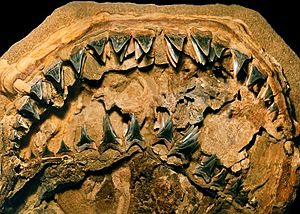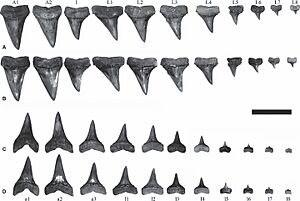Carcharodon hubbelli facts for kids
Quick facts for kids Carcharodon hubbelli |
|
|---|---|
 |
|
| Holotype jaws and teeth (UF 226255), also known as the Sacaco specimen | |
| Scientific classification | |
| Genus: |
Carcharodon
|
| Species: |
hubbelli
|
Carcharodon hubbelli, also known as Hubbell's white shark, was an extinct (meaning it's no longer alive today) type of white shark. This amazing shark lived between 8 and 5 million years ago, during a time called the Late Miocene and Early Pliocene epochs.
What makes C. hubbelli special is that it's a transitional species. This means it shows features that are in between older fossil sharks and the modern great white shark we know today. Scientists believe it helps us understand how the great white shark evolved.
Fossils of C. hubbelli have only been found in the Pacific Ocean region. They've been discovered in places like Peru, Chile, California, and New Zealand. This suggests that the great white shark might have first appeared in the Pacific Ocean.
This shark was named after Dr. Gordon Hubbell. He was the scientist who got the first important fossil of this shark in 1988. Dr. Hubbell gave the fossil to the Florida Museum of Natural History in 2009, helping scientists learn more about ancient sharks. C. hubbelli was about the same size as a modern great white shark, growing to be around 4.9 to 5.1 meters (about 16 to 17 feet) long. However, it grew a bit slower than today's great white sharks.
What Did Its Teeth Look Like?
Scientists have found only one complete set of teeth from C. hubbelli. This set includes 222 teeth and 45 backbone pieces. It was found in the Pisco Formation in Southern Peru.
The teeth of C. hubbelli look a lot like those of the modern great white shark. They are flat and triangular, with edges that have small saw-like bumps called serrations. However, there are some small differences.
For example, one specific tooth, called the upper intermediate tooth, points slightly backward in C. hubbelli. In the modern great white, this tooth points forward. Also, the serrations on C. hubbelli's teeth were finer and got smaller towards the tip of the tooth.
Because C. hubbelli is a transitional species, its teeth show a mix of features. Some features are like older extinct sharks, and some are like the modern great white shark. The backward-pointing intermediate tooth is like an older shark called Carcharodon hastalis. But the serrations and the size of some front teeth are more like the modern great white shark.
What Did It Eat?
The serrated edges on C. hubbelli's teeth suggest that it started to eat more marine mammals, just like the modern great white shark does. These sharp edges would have helped it cut through flesh.
Scientists found a bone from an ancient whale that had a C. hubbelli tooth stuck in it. This discovery helps support the idea that these sharks hunted or scavenged on large marine mammals.
See also
 In Spanish: Carcharodon hubbelli para niños
In Spanish: Carcharodon hubbelli para niños



